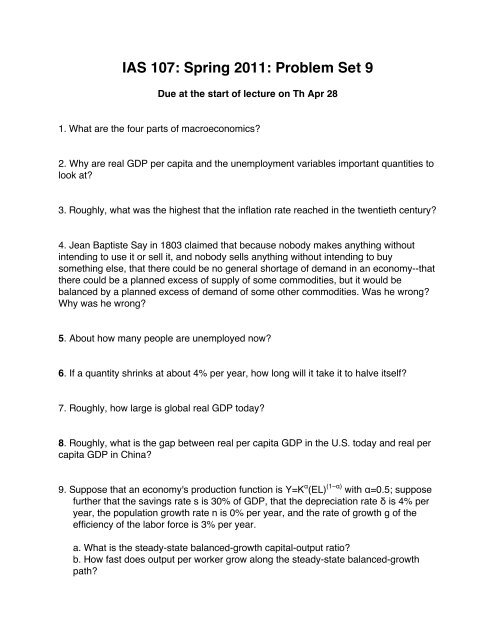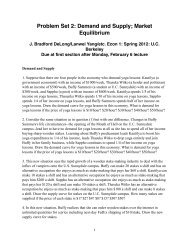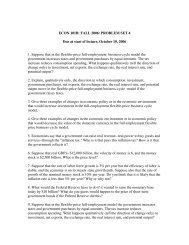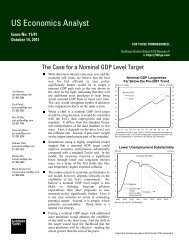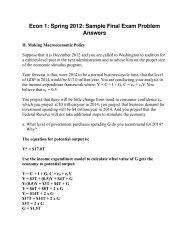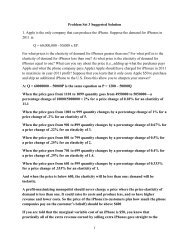20110118 IAS 107 pset9.pdf
20110118 IAS 107 pset9.pdf
20110118 IAS 107 pset9.pdf
- No tags were found...
You also want an ePaper? Increase the reach of your titles
YUMPU automatically turns print PDFs into web optimized ePapers that Google loves.
<strong>IAS</strong> <strong>107</strong>: Spring 2011: Problem Set 9Due at the start of lecture on Th Apr 281. What are the four parts of macroeconomics?2. Why are real GDP per capita and the unemployment variables important quantities tolook at?3. Roughly, what was the highest that the inflation rate reached in the twentieth century?4. Jean Baptiste Say in 1803 claimed that because nobody makes anything withoutintending to use it or sell it, and nobody sells anything without intending to buysomething else, that there could be no general shortage of demand in an economy--thatthere could be a planned excess of supply of some commodities, but it would bebalanced by a planned excess of demand of some other commodities. Was he wrong?Why was he wrong?5. About how many people are unemployed now?6. If a quantity shrinks at about 4% per year, how long will it take it to halve itself?7. Roughly, how large is global real GDP today?8. Roughly, what is the gap between real per capita GDP in the U.S. today and real percapita GDP in China?9. Suppose that an economy's production function is Y=K α (EL) (1−α) with α=0.5; supposefurther that the savings rate s is 30% of GDP, that the depreciation rate δ is 4% peryear, the population growth rate n is 0% per year, and the rate of growth g of theefficiency of the labor force is 3% per year.a. What is the steady-state balanced-growth capital-output ratio?b. How fast does output per worker grow along the steady-state balanced-growthpath?
c. How fast does total output grow along the steady-state balanced-growth path?10. Italy: Since 1946 Italian population growth (including illegal immigration) has beenconstant at about 1% per year and Italy has had a savings share of 25% of GDP.Today Italy has a GDP per capita level of about $25,000 per year. The rate of growthof the efficiency of labor in Italy since the end of World War II has been constant atabout 2% per year. Assume that Italy is today on its steady-state balanced-growthpath.a. If Italy remains on its current steady-state balanced-growth path, what will GDPper capita be in Italy in 2050?b. If Italy remains on its current steady-state balanced-growth path, what will GDPper capita be in France in 2100?c. What would Italyʼs level of GDP per capita have been back in 1946 if it had thenbeen on todayʼs steady-state balanced-growth path?d. In fact, Italy level of GDP per capita back in 1946 was about $2,500 per year eventhough its efficiency of labor has grown at 2% per year since the end of World War II.Why do you think its level back then was so low?11. Consider ΔY = [ΔA 0 + ΔG - (I r + X ε ε r )Δr]/(1-(1-t)c y + im y ), the investment savingsframework (with ΔA 0 = Δc 0 + ΔI 0 -X ε Δε 0 + X y* ΔY* + X ε ε r Δr*). Suppose theresponsiveness of exports to the exchange rate X ε = 500, the responsiveness of theexchange rate to interest rates ε r =10, and the responsiveness of investment to theinterest rate I r = 1000. And suppose t=0.2, c y =0.8 im y =0.14:a. What happens to Y if the real interest rate r goes up by 2%—by 0.02—and ifspeculator confidence in the currency goes down by 30%?b. What happens to Y if the real interest rate r goes up by 1%—by 0.01—and ifbaseline investment spending goes down by 300?c. What happens to Y if the real interest rate r goes down by 1%—by 0.01—and ifspeculator confidence in the currency goes up by 512. In the simple income-expenditure model with real GDP Y equal to the sum ofconsumption spending by households C, investment spending by businesses I,government purchases G, and with net exports NX; with consumption spending Cgiven by the equation: C = c o + c y Y(1-t); and with imports IM given by the equation:IM = im y Y...
c. If the Federal Reserve's target for the inflation rate is 4% and its target for theunemployment rate is 4%, what will the long run rate of inflation be?d. If the Federal Reserve's target for the inflation rate is 4% and its target for theunemployment rate is 8%, what will the long run rate of inflation be?ESSAYS19. Why did America have a housing boom in the mid-2000s?20. Why did the conditions that had been required for mortgage borrowers before 2000--20%down payment, evidence of a stable job, no more than a 33% ratio of housing expenses(including utilities and taxes) to income--disappear in the 2000s?21. Why did the world economy fall into a very deep economic recession at the end of 2008?22. Why is recovery from the current downturn in the United States likely to be partial anddelayed?23. Why are the economies of East and South Asia likely to grow much faster than the UnitedStates over the next half-decade or so?24 Why is America’s health care spending per capita so much higher than health care spendingin other industrialized countries?25. What will happen if America never brings its government revenues up to balance withspending, but keeps running federal budget deficits into the future?


